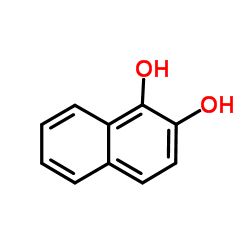benzocatechol

benzocatechol structure
|
Common Name | benzocatechol | ||
|---|---|---|---|---|
| CAS Number | 574-00-5 | Molecular Weight | 160.169 | |
| Density | 1.3±0.1 g/cm3 | Boiling Point | 353.9±15.0 °C at 760 mmHg | |
| Molecular Formula | C10H8O2 | Melting Point | 101-103 °C(lit.) | |
| MSDS | Chinese USA | Flash Point | 181.0±15.0 °C | |
| Symbol |

GHS07 |
Signal Word | Warning | |
|
Identifying chelators for metalloprotein inhibitors using a fragment-based approach.
J. Med. Chem. 54 , 591-602, (2011) Fragment-based lead design (FBLD) has been used to identify new metal-binding groups for metalloenzyme inhibitors. When screened at 1 mM, a chelator fragment library (CFL-1.1) of 96 compounds produced hit rates ranging from 29% to 43% for five matrix metallop... |
|
|
Selective antiproliferative activity of hydroxynaphthyl-beta-D-xylosides.
J. Med. Chem. 49 , 1932-8, (2006) The antiproliferative activity of the 14 isomeric monoxylosylated dihydroxynaphthalenes has been tested in vitro toward normal HFL-1 and 3T3 A31 cells as well as transformed T24 and 3T3 SV40 cells. The antiproliferative effect toward HFL-1 cells was correlate... |
|
|
Metabolism of acenaphthylene via 1,2-dihydroxynaphthalene and catechol by Stenotrophomonas sp. RMSK.
Biodegradation 20(6) , 837-43, (2009) Stenotrophomonas sp. RMSK capable of degrading acenaphthylene as a sole source of carbon and energy was isolated from coal sample. Metabolites produced were analyzed and characterized by TLC, HPLC and mass spectrometry. Identification of naphthalene-1,8-dicar... |
|
|
Prevention of naphthalene-1,2-dihydrodiol-induced lens protein modifications by structurally diverse aldose reductase inhibitors.
Exp. Eye Res. 68(5) , 601-8, (1999) The effects of aldose reductase inhibitors on lens protein modifications induced by naphthalene-1,2-dihydrodiol were investigated in vitro to confirm the role of aldose reductase on naphthalene cataract formation. HPLC analysis of naphthalene-1, 2-dihydrodiol... |
|
|
Metabolism of naphthalene by the biphenyl-degrading bacterium Pseudomonas paucimobilis Q1.
Biodegradation 2(2) , 115-20, (1991) Pseudomonas paucimobilis Q1 originally isolated as biphenyl degrading organism (Furukawa et al. 1983), was shown to grow with naphthalene. After growth with biphenyl or naphthalene the strain synthesized the same enzyme for the ring cleavage of 2,3-dihydroxyb... |
|
|
Metabolism of tetralin (1,2,3,4-tetrahydronaphthalene) in Corynebacterium sp. strain C125.
Appl. Environ. Microbiol. 59(2) , 567-72, (1993) Corynebacterium sp. strain C125, originally isolated on o-xylene, was selected for its ability to grow on tetralin (1,2,3,4-tetrahydronaphthalene) as the sole source of carbon and energy. The catabolism of tetralin in Corynebacterium sp. strain C125 was shown... |
|
|
Determination of dihydroxynaphthalenes in human urine by gas chromatography-mass spectrometry.
J. Chromatogr. B. Analyt. Technol. Biomed. Life Sci. 826(1-2) , 206-13, (2005) A gas chromatography-mass spectrometry (GC-MS) method was developed for measuring 1,2-dihydroxynaphthalene (1,2-DHN) and 1,4-dihydroxynaphthalene (1,4-DHN) in urine. The method involves enzymatic digestion of urinary conjugates to release the DHNs which were ... |
|
|
Identification of an extradiol dioxygenase involved in tetralin biodegradation: gene sequence analysis and purification and characterization of the gene product.
J. Bacteriol. 182(3) , 789-95, (2000) A genomic region involved in tetralin biodegradation was recently identified in Sphingomonas strain TFA. We have cloned and sequenced from this region a gene designated thnC, which codes for an extradiol dioxygenase required for tetralin utilization. Comparis... |
|
|
Production of trans-o-hydroxybenzalpyruvate from 1,2-dihydroxynaphthalene by cell-free extracts of Corynebacterium renale.
Indian J. Biochem. Biophys. 23(2) , 110-3, (1986)
|
|
|
1,2-Dihydroxynaphthalene as biomarker for a naphthalene exposure in humans.
Int. J. Hyg. Environ. Health 214(2) , 110-4, (2011) The possibly carcinogenic properties of naphthalene are, regarding to its ubiquitary presence, of environmental-medical and occupational-medical importance. Seven isomeric dihydroxynaphthalenes (DHN) were examined for their suitability as biomarkers in human ... |